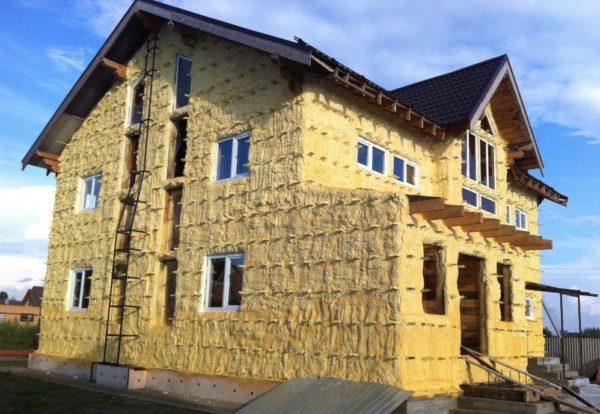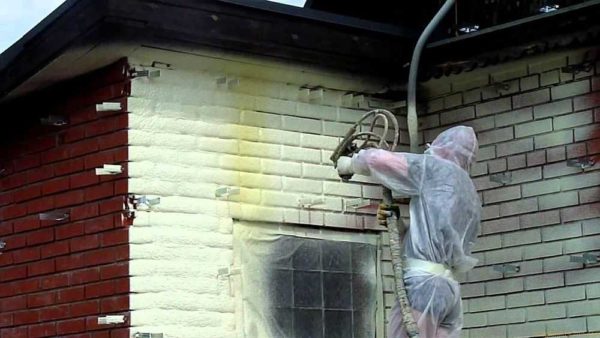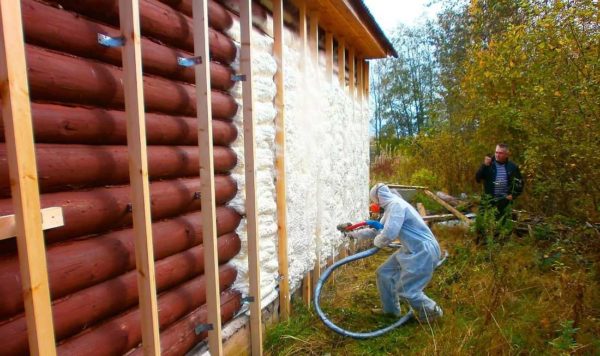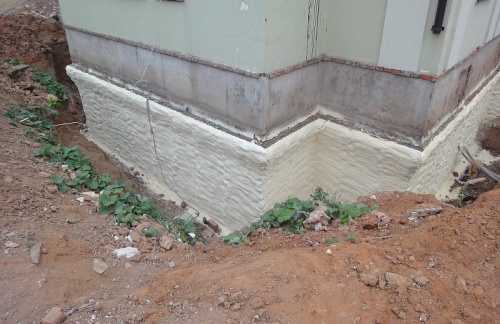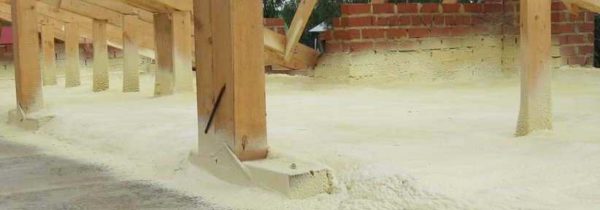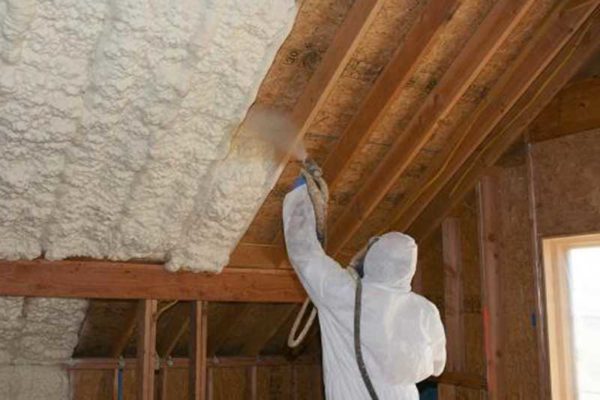Thermal insulation with polyurethane foam (PPU)
Energy prices are getting higher lately, and efficient home insulation is one of the main challenges that homeowners have to solve. One of the latest materials to hit the market a few years ago is polyurethane foam. This is a coating that is applied in a continuous layer to any (practically) surface. Insulation with polyurethane foam is the most effective.
The content of the article
Types of sprayed polyurethane foam and application technologies
Polyurethane foam is obtained by mixing two components - diisocyanate and polyol. Both components are individually toxic, therefore work is carried out with respirators. Mixing two toxic substances form a safe polymer - polyurethane - absolutely neutral, which does not react with any substances. After curing, polyurethane foam is completely harmless and is often used in the food industry.
When the two components are mixed, active gas formation occurs - mainly carbon dioxide is released. It turns out to be enclosed in the thinnest polyurethane shell, which gives high performance in thermal insulation (carbon dioxide does not conduct heat well).
The two components are mixed in a special high pressure gun. To obtain ideal foam, the components must be heated to 45 ° C (there are heated supply hoses, and there are special heaters). Under pressure, in the form of very fine dust, the components are mixed in a gun and sprayed onto the surface, where they foamed and then solidified. This is the essence of polyurethane foam insulation.
To achieve the stated material properties, diisocyanate and polyol must be fed in equal proportions. Even a slight increase in one or the other component negatively affects the characteristics of the material. Worse, if there is more diisocyanate - such foam quickly "sits down", then collapses, loses its heat-insulating characteristics. If you overdo it with polyol, the picture is a little better - the foam becomes brittle, but it fulfills its tasks, although it has a thermal conductivity higher than that stated. This is precisely one of the disadvantages of polyurethane foam insulation - the end result depends very much on the qualifications of the workers and the class of equipment used.
It is possible to mix the components in the given proportions almost perfectly precisely using high pressure installations. Therefore, when choosing a company, you need to pay attention to the equipment that is at their disposal - with low-pressure installations, you will most likely get a non-uniform spraying with poor thermal insulation characteristics.
But different equipment is not everything. There are also different types of polyurethane foam by cell type and density:
- Open-celled lightweight PU foam. In terms of characteristics (thermal conductivity) it is very similar to mineral wool, with the same main drawback - it is hygroscopic, while it costs much more than mineral wool. That is, when using lightweight polyurethane foam (density 9-11 kg / m3) it will be necessary to provide its hydro and vapor insulation from all sides, to organize a ventilated facade - to remove excess moisture. In the pluses, you can write a higher sound insulation (compared to mineral wool). It is used extremely rarely for insulation of external walls and roofs, since it simply does not cope with the tasks set - it gets wet and loses its thermal insulation properties. For all that, it is more expensive than mineral wool.But for the insulation of internal partitions and ceilings, it is used successfully (in combination with all hydro / vapor insulation layers), providing also good sound insulation.
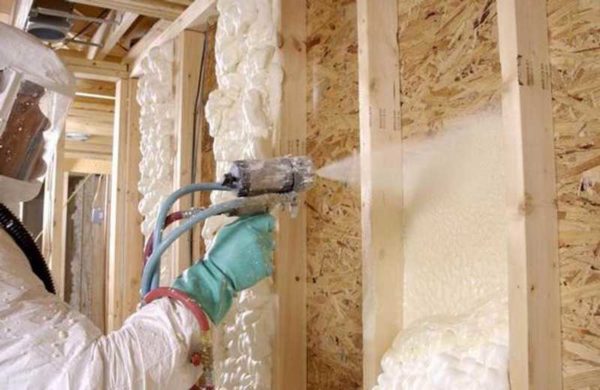
- Closed-cell polyurethane foam. Regardless of the density, it is not hygroscopic, it "adheres" very well to almost any surface, except for polyethylene. There are the following types:
- Medium density - 28-32 kg / m3... Standard solution when using sprayed thermal insulation on walls, ceilings, unexploited roofs. Provides good thermal insulation with a thermal conductivity coefficient of 0.02-0.028 (0.022 for air, lower only for vacuum). Average vapor permeability - 0.05 (comparable to wood).
- Medium density for filling cavities. The characteristics are similar to those described above, but expands more slowly, solidifies only after complete foaming. Used when constructing layered walls, roofs, etc.
- High density polyurethane foam - 40-80 kg / m3... It is used for insulating roofs in operation, under a screed, in other places with high mechanical stress. Due to the higher density, it has a slightly higher thermal conductivity coefficient - 0.03-0.04, vapor permeability is the same - 0.05.
In terms of prices, the cheapest is lightweight open-cell polyurethane foam. But if we add the need for a hydro and steam insulation device, then in general the price of insulation will not be so low. At the same time, it is still unrealistic to achieve ideal insulation, and it may well turn out that this type of PU foam insulation will be cold. So that you can navigate in prices, we give approximate prices for different types of PU foam (material + work):
- lightweight with an open cell from $ 180 per cubic meter;
- closed-cell medium density - from $ 650 per cubic meter.
Closed-cell polyurethane foam, per cubic meter, is much more expensive, but it does not require any additional layers, except for finishing. It is not afraid of water or steam, it fulfills its tasks for a long time (more than 25 years). The exact price of insulation with foam polyurethane foam depends on its density and layer thickness, the size of the sprayed surface. It is counted individually.
Advantages and disadvantages
Let's start with the merits:
- To date, polyurethane foam insulation is the most effective. This is due to the cellular structure of this insulation and the carbon dioxide contained in the cells. Ideally, this system gives a thermal conductivity coefficient of 0.02, which is even lower than that of air (0.022).
- Continuous, seamless spraying that negates the presence of cold bridges, further increasing the efficiency of insulation.
- The ability to spray on the surface of any, the most complex shapes.
- Low hygroscopicity. Along with insulation, you improve the waterproofing performance of the surface. This property is used when insulating foundations, wells and other similar structures.
- Excellent adhesion to all surfaces and materials except polyethylene. Excellent adhesion (adhesion) in some cases can be considered as a disadvantage - nothing can be washed off, since there is no solvent for PU foam. It can be cleaned only mechanically, often with fragments of the surface on which it was applied.
- Long service life - up to 25 years with the declared characteristics, later carbon dioxide is replaced by air, thermal conductivity increases, but not catastrophically, the sprayed thermal insulation continues to work.
- If during the first year, polyurethane insulation did not cause any complaints, the next couple of decades will not.
- When using high-pressure systems, the spraying of polyurethane takes a short period of time, and without compromising on quality.
- Sufficiently high vapor permeability of polyurethane foam - 0.05-0.06, which allows you to remove excess moisture through the walls, as well as before insulation (if the walls are vapor-permeable).
- Does not support combustion (self-extinguishing).
As you can see, there is a decent list of advantages that contribute to the fact that thermal insulation with polyurethane foam is gradually becoming more and more popular. But there are also disadvantages:
- High price - 1.5-2 times higher than with mineral wool insulation. But if you calculate for a year of service, it will not be more expensive.
- The end result is highly dependent on the equipment used and the poller's experience. Good results are achieved only with full adherence to technology.
- Due to the use of high-tech equipment, polyurethane foam insulation is very, very difficult to do with your own hands. There is a way out - to buy equipment by teaming up for several owners - in this, given the prices, there is a reason. But the question of having experience remains - it is very difficult to achieve normal performance on your own.
- The material does not burn, but it emits a lot of corrosive and harmful smoke when burning.
- Fear of ultraviolet radiation. Under the influence of sunlight, the foam melts, the white surface turns dark brown. But a film of a certain thickness protects the underlying layers from further destruction, so that with a sufficient thickness of the polyurethane foam, it can even be left open. But the appearance of the surface insulated with polyurethane foam is far from the best, so a finish is still assumed.
The main limiting factor in the spread of PU foam insulation is the high price. Although, if we compare with the cost of insulation with extruded polystyrene foam, the prices do not seem so high, and this despite the fact that the sprayed thermal insulation is stacked several times faster in time, gives the best result. In general, if you are planning to insulate your home, this technology is well worth researching.
Application conditions and surface preparation
Even with good adhesion, which is characteristic of polyurethane foam insulation, surface preparation will not be superfluous. First of all, you need to remove everything that crumbles - and first of all the old paint. Oily stains are also subject to mandatory removal and neutralization. They shouldn't be.
Anything that should not be covered with foam should be covered with plastic tape attached to it. It must be fixed carefully, without gaps - it is difficult to tear off the foam.
When insulating a roof with polyurethane foam, there are two ways to apply thermal insulation. The first is to make a permanent solid crate, onto which foam is poured. Second, a temporary frame is made, consisting of two parallel planes.
If the outer walls of the building are insulated with polyurethane foam, it is assumed that there is a finishing finish. And after cleaning the surface, you need to make sure that it can be strengthened on something - it will not work on foam. To do this, most often, wooden or metal strips are stuffed onto the walls, to which the exterior finish is then attached. This completes the preparation. But the application of polyurethane foam is possible only on a completely dry surface, at temperatures above + 10 ° C. There are no other conditions.
Spraying process
If you have entered into a contract with a company, a minibus will arrive at the appointed time. It has equipment for spraying. The high-pressure washer requires a voltage of 380 V. If you only have 220 V, the generator is usually started and produces the required voltage. A low-pressure apparatus can operate from a 220 V network, but, as mentioned below, the quality of thermal insulation will be much worse.
Usually, only the hoses are pulled into or around the house, through which components for the formation of foam are fed into the gun. It's comfortable. Workers who spray thermal insulation are dressed in protective suits, a respirator, gloves and goggles.A respirator is necessary, since the components of the foam are toxic before hardening, and everything else is to protect the skin from the ingress of polyurethane foam, which then cannot be peeled off.
The foam is applied from the bottom up, in small portions. Pour everything, without gaps, trying to prevent the formation of shells. As the foam expands, make sure that the layer thickness is not less than the required one. After the foam hardens, the excess can be cut off, and nothing can make up for the deficiency.
Spray insulation parameters
It should be said right away that, as for any other insulation, it is preferable to insulate the walls of buildings from the outside. If insulate from the inside, then the outer wall will freeze through. How many defrost / freeze cycles it can withstand depends on the material, but rarely will such a house last more than 10 years.
When insulating with polyurethane foam outside, a finishing external finish is required - the surface has a very unattractive appearance. But there are no problems with the freezing of the walls, the building will serve for a long time.
There are no problems with the roof at all. Roofing materials are designed for repeated freezing, so that insulation with polyurethane foam of the roof can be done from the inside, by spraying it directly on the “wrong side” of the roofing material or on the crate.
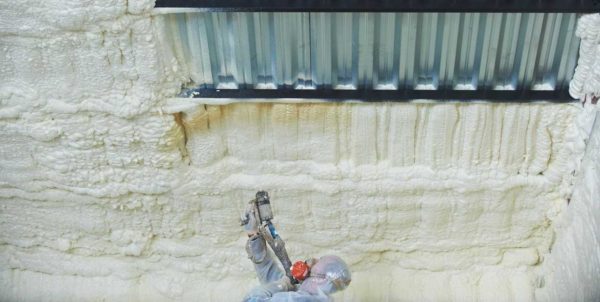
Sprayed thermal insulation can be applied to any surface, and the roof can be insulated from the inside
Insulate the house outside or sorted out from the inside. Now a little about the layer thickness. Insulation with polyurethane foam is usually done with a large thickness. This is not because small is not enough. Usually, just according to the thermal characteristics, a thickness of insulation of 2-3 cm is required, but they do it at least 5 cm.This is so that under any conditions the dew point is in the thickness of the thermal insulation, and not in the wall material. Since polyurethane foam is non-hygroscopic, it cannot get wet, condensation simply does not occur, and excess moisture is removed naturally due to the vapor permeability of the material.

